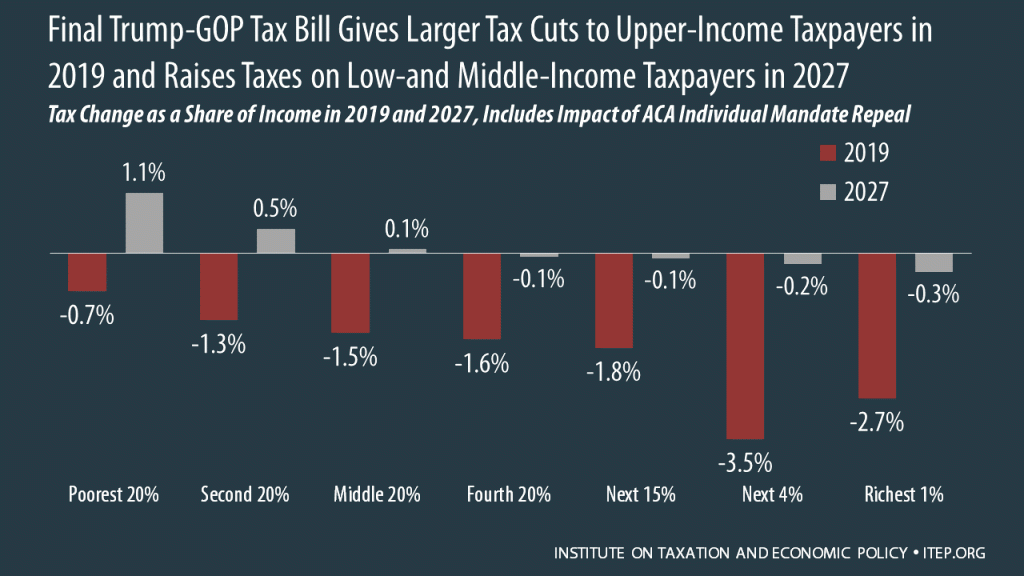The Walt Disney Corporation announced this week that in the wake of the new tax law, it will spend $125 million on one-time bonuses and $50 million on an education program for some employees, all in 2018. This $175 million spending commitment is notable for two reasons: one, it’s temporary, and two, it’s a drop in the bucket for a company that’s likely to see annual tax savings of $1.2 billion a year and has already committed to a $52 billion corporate acquisition of 21st Century Fox’s assets.
Over the past five years, Disney’s current and deferred federal income taxes totaled about $3.3 billion a year. Cutting the statutory tax rate from 35 to 21 percent should shave the company’s tax bill by 40 percent—more than $1.3 billion a year.
Even after factoring in the loss of the manufacturing deduction, which was repealed by the new tax law, Disney’s annual tax savings could easily still reach $1.2 billion a year. (This estimate is based on the limited data the company does disclose. As a caveat, the 500-page tax bill makes dozens of changes to the corporate tax laws, some of which could affect Disney’s tax rate in ways that aren’t disclosed in its annual financial reports.)
It’s not surprising that Disney leaders would feel compelled to send some of its newfound billions to its employees. Opinion polls show American workers believe (correctly) the new tax law will benefit big corporations and the wealthy more so than working families. Corporations are well aware of this public relations problem, and they’ve been trying to fix it. Since the tax bill passed, there’s been a continual stream of corporate announcements declaring corporations will be sharing their newly found riches with their employees via one-time bonuses or increases in their minimum wages. Disney is jumping on the corporate propaganda wagon in making this high-profile media announcement.
And it seems this steady drumbeat of corporate announcements is beginning to have its intended effect. The public still believes the bill will mostly benefit the rich, but by a smaller margin than at the end of 2017.
It is true that a one-time bonus provides some benefit for employees, but it doesn’t immediately follow that Disney and other corporations’ recent action will result in a sustained, resolute corporate effort to permanently increase rank and file workers’ wages in a meaningful way. Most economists agree it will take years before we can measure whether these supply-side tax cuts have had their promised effect. If history is any indication, the wealth will not trickle down. Notably, neither Disney nor other companies that have distributed bonuses has said anything about repeating their bonus largess in years to come.
Even if Disney chooses to repeat its promised worker bonuses annually going forward, it’s still reserving the lion’s share of its tax savings for its bottom line. In other words, about 85 percent of the company’s annual tax cut will be used in ways that haven’t been highlighted in a splashy press release.
It’s also worth noting that the value of Disney’s promised employee bonuses are a tiny fraction of its pending $52 billion acquisition of 21st Century Fox assets announced late last year. In other words, the company had more than enough on hand to invest in its workforce or create new productive capacity, but it chose instead to acquire another company, prompting one observer to argue that in the corporate world of 2017, “no one knows what to do with their money.”
Almost all economists, and many CEO’s to boot, voiced skepticism last fall that corporate tax cuts would lead to new capital investment or job creation for exactly this reason: Fortune 500 corporations as a whole were already sitting on more cash than they knew what to do with. If Disney or other firms wanted to boost worker pay or hire more workers, they could easily have done so in 2017. The most sensible interpretation of Disney’s newfound, and temporary, bonus spree is that the company recognized an immediate public relations need.




